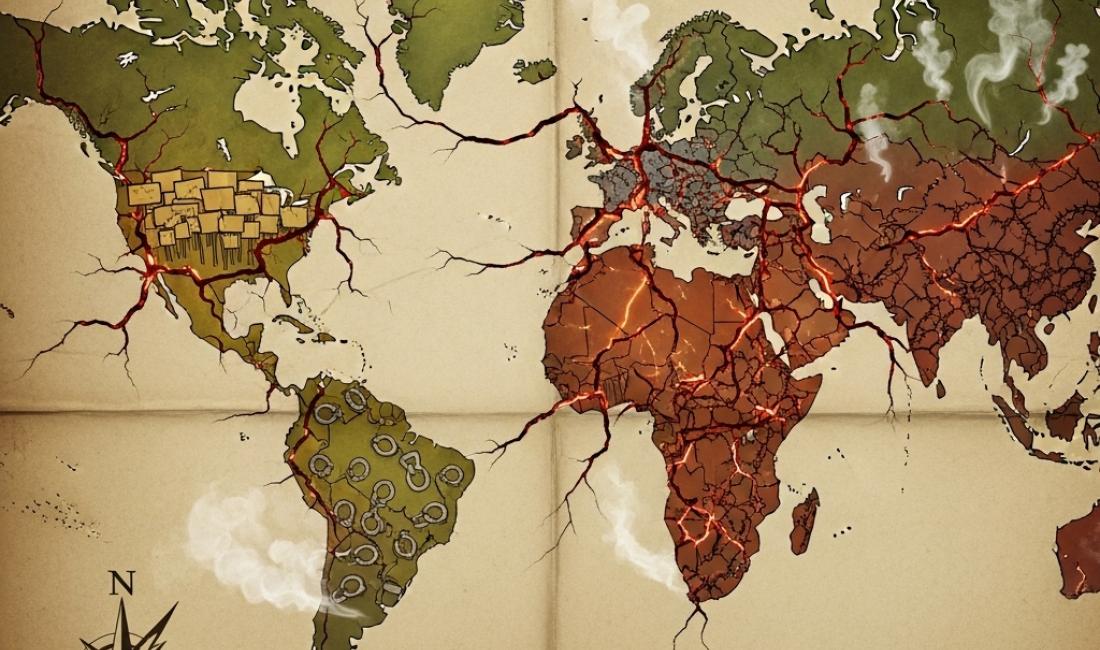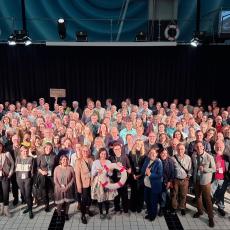And What Democratic Innovations Can Do About It
This piece is republished from the National Civic Review.
An all too familiar adage is that democracy is struggling. Trust in institutions has waned, and disaffected constituencies are increasingly frustrated with living conditions, leading to problematic perceptions of elected officials and policymakers. However, the prevailing diagnoses are limited to polarization, disinformation, social media, institutional dysfunction (lack of transparency or accountability), and citizen apathy or miseducation. While undoubtedly relevant, these factors fail to pinpoint an economic dimension. Where people live disproportionately impacts people’s quality of life, and many places struggle with supporting their people. It’s not just that political processes are weakened by democratic malaise but that communities cannot strategically reverse decades of declining social mobility, sectoral degeneration, stagnating wages and income, rising debt-to-income ratios, housing unaffordability, high inflation and limited purchasing power.
This article argues that current narratives of democratic apathy and decline fail to account for the underlying structures that shape civic disaffection. The current wave of democratic disenchantment is a geographical revolt against dominant economic models supported by traditional electoral political systems. Practitioners and pundits fail to reflect on the impact of what it means for whole regions to be written off, often focusing on political or policy solutions that involve re-engaging citizens without changing their economic circumstances.
Most people in the field of civic engagement are interested in reversing the enduring democratic recession. However, the economy feels as though it’s not something that democratic participation can or should tackle, or it is just too out of reach, and we don’t know how they should be interconnected. Otherwise, we’d see more concentrated effort and discourse around economic themes, not just creating better interactions between the public, elected officials, and formal institutions. This partly stems from a problematic separation of politics and economics and having spheres delimited to specific elite actors rather than any meaningful regulatory role for the public.
We cannot simply strive to reform existing democratic institutions without also substantially reimagining how societies govern people’s social and economic well-being. Conscious democratic interventions require an economic lens, not as an adjacent or peripheral piece of decision-making empowerment. Reworking the role of the public in regional economic infrastructure and regeneration is a vital piece to this puzzle.
Recent literature on place-based political economy and democratic innovations highlights the challenges around systemic geographic exclusion and economic decline. This article proposes that democratic renewal requires new infrastructure rooted in participatory economic governance and spatial wellbeing, including citizens’ assemblies, participatory industrial strategy, regional economic councils, and economic democracy zones.
The Geography of Political Discontent
In his influential 2020 work, The Rise of Populism and the Revenge of the Places That Don’t Matter, Andrés Rodríguez-Pose locates the roots of discontent in long-term regional decline. The most fervent support for populist movements stems from people in regions that have experienced economic stagnation, depopulation, and political neglect. These places once thrived under industrial economies but were cast aside by the rise of the globalized, knowledge-based economy. In Europe and the United States, geographic inequality manifests through a growing divergence between “superstar cities” and left-behind towns. Populist sentiment surges in areas where GDP has contracted, job opportunities have disappeared, and people feel economically excluded and politically irrelevant.
As Andrés Rodríguez-Pose, Javier Terrero-Dávila, and Neil Lee note, marginalized regions are reasserting themselves nationally, which should challenge democratic reformers to rethink their approach to engagement. The common concern that people lack civic education or are misinformed misses how entire geographies of people lack meaningful civic and economic opportunities. The economic root of populism revolves around a lack of access to resources, and populist voting is especially high in economically declining regions. But this isn’t just a matter of poverty and rising inequality, despite being a driver of populism. There is an overlap between limited social capital, political and institutional neglect, and economic divergence.
In Europe, economic decline, including falling GDP and deindustrialization, strongly correlates with support for far-right populism, especially in high-immigration areas. Economic stagnation and rising inequality matter in the United States when combined with racial homogeneity. Counties that are mainly white and stagnant are more populist; more diverse counties are not. The places that “don’t matter” like they once did to industrial production are left behind in the transition to knowledge and service-based economies. The concentration of opportunity in a few urban regions has hollowed out mid-sized cities and industrial towns.
Place, Participation, and the Limits of Civic Infrastructure
Parallel to economic woes are limited opportunities for the public to “triage” problems, i.e. respond to isolated issues without addressing their underlying structural causes. Rather than integrated systems of place-based democracy, residents face a civic landscape shaped by top-down reforms, uneven institutional support, and disconnection across neighborhoods and different levels of government. Civic actors must work “within the crevices” of city structures to advocate for their communities.
Even promising democratic innovations can frequently fall short because they are not embedded, are under-resourced, or limited in scope and fail to elevate the well-being of people. What’s missing is a democratic system that is geographically integrated and institutionally enables collective decision-making in development, infrastructure, and investment. Moving people to prosperous areas isn’t a solution for those unwilling or unable to leave their homes, histories, and communities. So, place-sensitive, long-term economic strategies are needed, but how can they be provided? There is a dual problem that needs to be solved. Where the hollowing out of economic systems has negatively impacted regional civic life, limited elite-driven designs cannot fix democratic deficits. Similarly, many urban civic networks fail to connect people meaningfully across space.
A commonly advocated solution is implementing democratic innovation, but this approach primarily focuses on institutional design changes such as making public forums more deliberative, inclusive, or representative. This focus has often operated in isolation from the political economy. To democratize democracy, we must confront not only how people vote or deliberate but also who benefits from growth and the placement of industry and who gets to shape the future of their community.
If voters in left-behind places are rebelling at the ballot box, then the dislocation of opportunity and voice across regions or within cities has a role in current democratic crises. But we can’t just rely on technocratic development models or participatory processes that fail to tackle economic marginalization and inequality. Democratic renewal is possible if we contend with economic realities through new governance structures and relationships.
Four Innovations to Build a Better Democratic Infrastructure
To address geographical discontent, we might combine four innovations to form a democratic infrastructure that is geographically and economically integrated.
1. Regional Citizens’ Assemblies
These are randomly selected to be demographically and regionally diverse deliberative bodies empowered to establish regional development priorities. These assemblies would respond to the lack of political voices in declining regions. By anchoring deliberative democracy in place-based representation, regional citizens’ assemblies would help to identify shared goals and provide public support for regional strategies.
The regional focus directly responds to geographical inequality by operationalizing democracy to avoid the fragmentation of civic spaces and the lack of spatial coordination. This strategy is vital for democratizing regional planning, mitigating structural economic causes of regional decline, and rebuilding lost legitimacy in marginalized areas. An example would include East Belgium’s Citizens’ Council, a permanent council selected by lottery that sets the public agenda for the regional parliament. This council is regionally rooted and legislatively linked. Ultimately, the scope for these assemblies would be to set regional development priorities, e.g., infrastructure, climate adaptation, education, transportation, and employment. The mandates would be preferably binding in some areas and responsible to some form of regional or sub-regional government.
2. Participatory Industrial Strategy
Multi-stakeholder forums (workers, municipalities, businesses, unions, residents) should co-determine infrastructure, innovation, production, and investment priorities, especially in response to public surpluses, tariffs, or green transitions. Economic development is too important to be left to technocrats or market actors. This model builds from the insight that economic democracy is the missing layer in democratic reform. It moves democratic participation into the heart of supply chains, funding decisions, and production strategies. Forums could oversee how revenue from public corporations or carbon pricing is reinvested into regions, coordinate industrial transitions, and ensure that marginalized communities benefit from economic change.
Aiming for a comprehensive industrial strategy addresses the critique that current democratic practices have little influence over the economy. It moves beyond “input-based” participation into structural economic decision-making by creating pathways for incorporating worker knowledge, regional expertise, and public values into industrial development. Opening up capital allocation and surplus distribution (e.g., from tariffs or public corporations) to democratic input helps mitigate the structural economic causes of regional decline by making localities part of the value-generation process. Examples include worker cooperatives that collectively plan production and investment through co-governed institutions like banking, education, and innovation systems (e.g., the Mondragon Corporation in Spain) and France’s Regional Economic, Social, and Environmental Councils, which are consultative bodies that include labor, business, and civic actors in advising on regional economic development. As such, the outputs would entail some regional implementation power involving binding budgetary input.
3. Regional and Supra-Municipal Economic Councils
These are elected or hybrid bodies with legal authority over regional economic and development decisions designed to cut across existing political boundaries. Considering that governance structures often don’t match the scale of real-world economic challenges, these councils create a middle level of democratic coordination beyond the municipality, but below the state or federal levels, to tackle housing, transit, energy, and workforce planning at the correct scale. These elected bodies with development authority are not confined to traditional political boundaries. Such institutions could host citizens’ assemblies or industrial strategy forums, serve as investment boards for shared regional projects, and negotiate with upper levels of government on behalf of their territories. These councils address a governance void by correcting the uncoordinated siloing of public engagement that fails to address systemic issues (e.g., housing, transportation, jobs) and institutionalizing a new democratic layer outside the boundaries of traditional federalism.
Examples to build upon include the Combined Authorities in the United Kingdom, which are supra-municipal bodies with economic and planning authority over multiple municipalities, the Portland Metro Council in Oregon, which is an elected regional government overseeing land use, transportation, and economic planning, and Finland’s Regional Councils, which are responsible for economic development, environment, and land use across multiple municipalities. Such structures could include some mixture of elected and appointed members from across municipalities and sectors. The types of power might consist of tax allocation, economic development funding, and regional and housing strategies. Citizens’ assemblies and/or participatory budgeting could provide accountability. The jurisdictions are more aligned with functional economic areas.
4. Economic Democracy Zones
These are more localized networks of public banks, community land trusts, cooperative incubators, mutual aid networks, and community wealth-building. They act as local anchors to support local businesses while also embedding participatory governance into the ownership and operation of economic assets. Examples include community wealth building, involving public procurement to anchor local employment and cooperative development, such as in Cleveland, Ohio, and Preston, United Kingdom, public banks like the Public Bank of North Dakota, the only one in the U.S. that is publicly owned to finance housing, small businesses, and worker co-ops, and community land trusts like the Dudley Street Neighborhood Initiative in Boston, where land and housing is bought and made affordable and governed collectively by the community.
These networks provide a foundation to embed economic democracy directly into local infrastructure by anchoring abstract democratic innovations into tangible, community-controlled assets. Often, these involve democratic governance mechanisms, with residents, workers, public officials, and community stakeholders having seats at the table and decision-making influence. They can redirect taxes, revenue, or profits to invest locally and create long-term local capacity and civic institutions. This offers a path to physically ground spaces that strive to uplift well-being.
Toward a Politics of Geographic Economic Wellbeing
Together, these proposals form the foundation of a civic infrastructure that can address aspects of the enduring democratic malaise because people are asked to restructure the terrain on which participation happens. The proposals address two blind spots in the current democratic reform discourse: that democracy must be equitably distributed across geography, and there needs to be a commitment to embed democratic decision-making in macroeconomic initiatives.
These approaches could treat the anger, grief, and mobilization emerging from left-behind places as one way to develop generative political discourse. The connection between the interventions involves citizens’ assemblies generating grounded public priorities, participatory industrial strategy embedding those priorities in production and investment, regional economic councils coordinating implementation across jurisdictions, and economic democracy zones that make local decision-making relevant to everyday life. These innovations are not new but have yet to be systematically connected. Perhaps by integrating them, regions might be revived because democracy is at a scale that is more able to solve problems across diverse geographies.
Conclusion
Addressing political discontent would be an opportunity to reimagine what democracy is. Returning to mid-century elite-driven growth or implementing participatory and deliberative models that ignore economic and geographic exclusions lacks vision. It elides the realities of the economic nature of political discontent and the underwhelming strategies that have been promoted to date. Democracy must be where people live and give them some influence over the economic systems that shape their lives. Places and regions cannot be treated as passive backdrops either. The aim of connecting place-based democratic experimentation with regional governance and economic planning would be to move beyond restoring trust in our democracy and toward wholly new democratic capacities.




